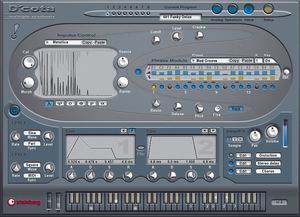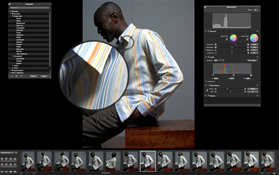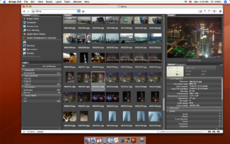The invasion of "glamor." Fashion trends in GUI design.
 In the mid-nineties, with the development of desktop publishing systems and in connection with the penetration of the graphical interface into the masses (along with Windows), non-standard graphical interfaces began to be widely adopted. One of the apologists for this direction was Kai Krause, the now almost forgotten GUI design guru, who worked for the small company HSC, which later merged with Fractal Design (the manufacturer of the first versions of Painter) was renamed Metatools, then Metacreations, and then completely skimmed into pieces Corel, Procreate and other companies. The first experience in designing non-standard interfaces was really boldly implemented in plug-ins for photoshop, the most famous of which is Kai's Power Tools ...
In the mid-nineties, with the development of desktop publishing systems and in connection with the penetration of the graphical interface into the masses (along with Windows), non-standard graphical interfaces began to be widely adopted. One of the apologists for this direction was Kai Krause, the now almost forgotten GUI design guru, who worked for the small company HSC, which later merged with Fractal Design (the manufacturer of the first versions of Painter) was renamed Metatools, then Metacreations, and then completely skimmed into pieces Corel, Procreate and other companies. The first experience in designing non-standard interfaces was really boldly implemented in plug-ins for photoshop, the most famous of which is Kai's Power Tools ...Then followed the equally legendary Kai's PowerGoo, Soap, Convolver and the truly monstrous Bryce, Poser and Carrara. The success of bright, unusual, but professionally executed solutions Krause spawned a whole galaxy of good and not so much attempts to go beyond the boring set of interface elements offered by Windows, MacOS and Unix. Most of the unusual interface featured plug-ins for Photoshop, AfterEffects and Painter. Although none of the well-known programs could come close to the level that Kai Krause set in his applications. Its unexpected forms of non-rectangular windows, metal buttons and translucent panels a dozen years ago evoked a wild delight in any uninitiated. Many people put in their KPT or Bryce only for aesthetic pleasure to move some translucent lens with sliders on top of the picture. However, over time, MetaCreations products became increasingly ergonomic, all these graphical delights were smoothed and simplified, although OS elements were also not used. As a result, when the company ceased to exist, and the programs were bought out, Kai Krause himself lost his place somewhere, by the beginning of the new millennium, interest in non-standard GUIs had disappeared.

Interesting solutions could be seen only in two sectors of software: music editors and three-dimensional modeling programs. The industry of VST-plug-ins for music software was especially rapidly developing.
Here and to this day you can find amusing copies of the graphical interface. Someone such decisions seem redundant, but someone is used and can not live without them. As a rule, controls are similar everywhere (buttons, sliders, checkboxes, lists, etc.), but their design and interrelationships often differ.
')
Recently, programs with a non-standard interface that differs from the GUI of operating systems began to appear. Especially a lot of "glamorous" dark interfaces. Moreover, such software is not produced by small companies that stamp Photoshop plug-ins, but by quite serious giants of the software industry. Adobe introduced the "dark" Lightroom and Bridge. Apple marked Aperture and Logic. Even Microsoft could not resist and presented the latest version of Windows Media Player in the fashionable now "gothic" shade. What is this - a new trend in the field of GUI design? And should we expect the emergence of a new large-scale wave of non-standard interfaces? Especially in the dark scale ... Is this good or bad? How convenient or inconvenient to work with such applications? Does this affect fatigue, productivity and creativity? Or does the color and shape of the interface elements in no way affect the workflow, and can the GUI of the program be anything?



It would be interesting to know the opinion of Habra-people regarding all these fashion trends, as well as to see links to examples of the most interesting and unusual GUI-ideas.
Source: https://habr.com/ru/post/20531/
All Articles